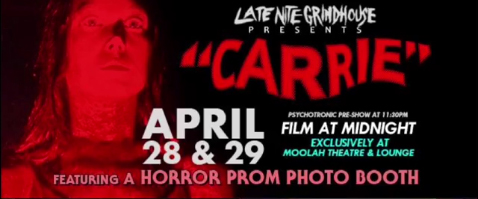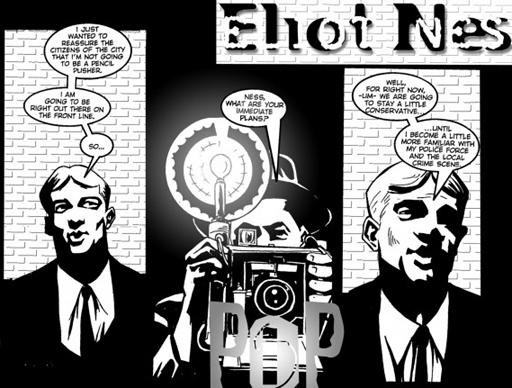DUCOURNAU ON HER DIRECT 'CARRIE' WINK IN 'RAW'
MEANWHILE, SEVERAL CRITICS SEEM TO BE REMINDED OF DE PALMA'S 'SISTERS', AS WELL Julia Ducournau
Julia Ducournau's directorial debut,
Raw, opened a couple of weekends ago. Several reviews have mentioned
Brian De Palma, as well as other filmmakers, as potential influences, and specifically De Palma's
Carrie and
Sisters, in relation to
Raw. In the first link/excerpt below, Ducournau explains to Dan at Geekadelphia why
Carrie was the only consciously deliberate reference she made to any film. Following that are links to other reviews of
Raw:
Geekadelphia's Dan interviews Julia DucournauYou combine in your narrative social commentary, comedy, gender and horror so effortlessly and fluid in Raw. What were some of the influences that helped you craft the film? So the thing is when I write and I direct, I really, really try for once not to watch the movies that I love to watch in real life. I try not to be tempted to reproduce anything, I am kind of scared of that. I never go back to my main influences when I do the job. The funny thing is I do not make any direct reference to any of the main filmmakers, like Cronenberg, Argento or Lynch who are a holy trinity in my life. There is a however a direct Carrie reference, you know Brian De Palma. Carrie is a movie I like very much but it wasn’t a foundation experience for me, even though I love it, like how strong it is with a Cronenberg for example.
I did it because lots of members in the audience would think to themselves the premise of the movie, so I decided to make a small wink to it and play with this reference so we can move on to the next scene.
A lot of people have said they see Suspiria, and its funny because Suspiria was one of the biggest shocks in my life when I saw it. Even though I didn’t think about it when I was writing or directing, when someone tells me this, I am like yeah I think I understand it. Somehow its unconscious, but your identity is also what you’ve watched, what you’ve liked and what you’ve reacted to.
Joseph Friar, Victoria Advocate"Many of the film’s gory moments are reminiscent of Cronenberg’s style and there is an ode to De Palma’s Carrie when the group of incoming freshman are doused with buckets of animal blood. However, the film shocks the most when it does it in a subtle way and Ducournau manages to fool the audience into believing that they are watching a coming-of-age drama that suddenly becomes the perfect double bill with Hannibal or one of my favorites Ravenous. But here the audience never loses sight that Justine is not becoming this terrible monster by choice. She can’t seem to escape what the future has in store and even when she begins to do the unthinkable the audience still finds itself rooting for her to find a way out. Raw is a brilliantly executed horror film that instantly becomes a classic of the genre. The final act is both shocking and satisfying."
April Wolfe, LA Weekly
"The women’s competitive, murderous relationship suggests the psychodrama of Brian De Palma’s Sisters, which tells of separated conjoined-twin serial killers, but in Raw the soul siblings hurt themselves just as much as they hurt other people. When Justine smears lipstick on her face and grinds her hips into a mirror to a song whose chorus is literally “I like to bang the dead,” or when she rips her teeth into her own arm to quell her cravings, these scenes echo Andrzej Zulawski’s Possession, in which a woman is so wracked by sexual madness that she hurls herself over and over into a wall in a subway tunnel.
"A scene where drunk-on-passion Justine rips into her kissing partner’s lips, snagging a tasty chunk of flesh, brings to mind Claire Denis’ archetypal cannibalistic-love thriller Trouble Every Day. But Raw isn’t derivative — it’s fresh, funny and grounded in reality. Underneath all the blood and guts, this is the story of a woman whose body demands love in extremity and the only person who’ll ever understand her fully: her sister."
Peter Keough, The Boston Globe
"Ducournau has some brilliant set pieces to come. A couple, one painted blue, the other yellow, make love, forming green until an abrupt interruption. And in one of the most disturbing horror scenes so far this year, we learn that a human finger tastes like curry.
"But then Ducournau throws in subtexts of patriarchal tyranny, elitism, vengeful mediocrity, colonial exploitation, homophobia, eating disorders, incest, sibling rivalry, and vegetarianism. Plus, a handsome array of allusions to such directors as David Cronenberg, Alfred Hitchcock, and Brian De Palma. But we never get much closer to answering the key question — what’s eating Justine?"
Steve Erickson, Nashville Scene
"Sisterhood is powerful. It’s also powerfully damaged, according to the exciting French horror film Raw. Writer-director Julia Ducournau synthesizes the influences of Claire Denis (especially her film maudit Trouble Every Day) and David Cronenberg, while paying explicit homage to Brian De Palma and Alfred Hitchcock. Like many of the best films, Raw remains enigmatic to the end. I could list a dozen subjects and themes that it’s about, but in the end, it resists being reduced to a metaphor or, even more so, a message. Ducournau captures the sense of terror and the sheer oddity powering the best work of horror writers like Poppy Z. Brite and Clive Barker."
Kalyn Corrigan, Birth. Movies. Death.
In both Sisters and in Raw sexual acts prompt and coincide with the tendency toward violent acts. Just as Danielle discovers that she is as protective and violent towards anyone who tries to insert themselves between she and Dominique, Justine realizes that she, too, wants to keep her sister all to herself, because only her sister truly understands her -- the same can arguably be said about Alexia’s feelings toward Justine. Both stories feature women who evolve into more actualized human beings once their sisters pave the way to understanding themselves. Only the one who shares the same infected blood can point the way to self-acceptance, and only your sister will truly be there for you when you have a body that needs disposing of. It takes a true sibling to stand by your side while you’re holding a bloody kitchen knife in your hand – or, in certain circumstances, a bloody ski pole. The inspiration for Sisters actually comes from a startling image that director Brian De Palma stumbled upon in an article in a 1966 issue of Life Magazine. The picture showed two conjoined Soviet twins named Masha and Dasha, and a caption in the bottom right corner reads something along the lines of “Although they are physiologically normal, as they get older, they are starting to develop mental problems”. Intrigued by this strange scenario, De Palma dreamed up a story about two Siamese twins who would eventually be surgically separated, resulting in one sister going mad and attacking any man who would dare try to date her one and only human connection. Influenced, as always, by Hitchcock, De Palma took his grand idea of a sibling set slasher and filled it to the brim with nods to his favorite filmmaker, giving it a very Psycho first act, as he kills off a lead character more than thirty minutes in, followed up by a small Rope homage as he uses as long of a take as possible to show the detective and reporter Collier making their way around Danielle’s apartment while looking for a body, all the while keeping a cool Rear Window style ever present with several characters watching important plot points develop through binoculars, typically from across the street, just as Jimmy Stewart does as Hitchcock’s classic wheelchair bound neighborly hero. During the editing process, he and Paul Hirsch even grew to believe it was necessary to get Bernard Herrmann to do the score.
De Palma is not character driven or a man of many words. He finds that too much chatter makes for a dull movie, and instead opts to find inspiration in a large set piece, or a big idea, and then shapes his story around that idea to match the image that he has in his head. Likewise, Raw director Ducournau is more into scoring long moments of silence rather than incorporating a ton of dialogue to explain what’s happening, and finds herself inspired by images of certain peculiar body movements, which she then uses as a jumping off point to build a narrative around. Therefore, although each director has his or her own way of doing it, the story actually comes second to the aesthetics for both filmmakers. Despite the difference in age, sex, birthplace, and point in time, they do share the habit of conjuring up strong visceral visuals and writing whatever is necessary to bring that visual to life.
In the case of these films, both of those visuals eventually came to involve sisters, and each showed the power of coming to terms with one’s own identity through the guiding force of her own female sibling. Blood, sex and carnage lined the path to self-actualization, but once each sister sets out to find herself, there was no turning back from the murderess that they would inevitably become.







 Laurent Bouzereau, who wrote The De Palma Cut (1988) and went on to produce special feature documentaries for several Brian De Palma films (as well as for Steven Spielberg and others), is the director of the new three-part Netflix mini-series Five Came Back, which is based on Mark Harris' book about five legendary filmmakers who applied their filmmaking skills to documentaries about World War II, and how their war experiences effected the films they made upon returning to Hollywood. In the Netflix series, Steven Spielberg, Francis Ford Coppola, Guillermo del Toro, Paul Greengrass and Lawrence Kasdan discuss the directors of Harris' book: Frank Kapra, John Ford, George Stevens, William Wyler and John Huston.
Laurent Bouzereau, who wrote The De Palma Cut (1988) and went on to produce special feature documentaries for several Brian De Palma films (as well as for Steven Spielberg and others), is the director of the new three-part Netflix mini-series Five Came Back, which is based on Mark Harris' book about five legendary filmmakers who applied their filmmaking skills to documentaries about World War II, and how their war experiences effected the films they made upon returning to Hollywood. In the Netflix series, Steven Spielberg, Francis Ford Coppola, Guillermo del Toro, Paul Greengrass and Lawrence Kasdan discuss the directors of Harris' book: Frank Kapra, John Ford, George Stevens, William Wyler and John Huston.
 U.K. magazine
U.K. magazine  Yesterday,
Yesterday,  "We even had a Halloween scene, with Alex running around in a Kabuki mask, terrorizing the household," noted Dearden.
"We even had a Halloween scene, with Alex running around in a Kabuki mask, terrorizing the household," noted Dearden. 

 Julia Ducournau's directorial debut, Raw, opened a couple of weekends ago. Several reviews have mentioned Brian De Palma, as well as other filmmakers, as potential influences, and specifically De Palma's Carrie and Sisters, in relation to Raw. In the first link/excerpt below, Ducournau explains to Dan at Geekadelphia why Carrie was the only consciously deliberate reference she made to any film. Following that are links to other reviews of Raw:
Julia Ducournau's directorial debut, Raw, opened a couple of weekends ago. Several reviews have mentioned Brian De Palma, as well as other filmmakers, as potential influences, and specifically De Palma's Carrie and Sisters, in relation to Raw. In the first link/excerpt below, Ducournau explains to Dan at Geekadelphia why Carrie was the only consciously deliberate reference she made to any film. Following that are links to other reviews of Raw: